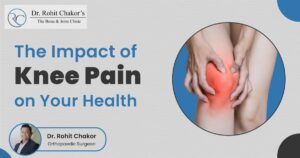The explore common orthopaedic conditions, their causes, symptoms, and the various treatment options available at our “The Bone & Joint Clinic”. We delve into the expertise of renowned orthopaedic specialist, Dr. Rohit Chakor, who specializes in a wide range of services including Joint Replacement, Arthroscopy & Sport Injury, Spine Surgery, Pediatric Orthopedics, Deformity Correction, Fractures, Ligament Injuries, Back and Neck Pain, Foot and Ankle Surgery, Hand Injury, and Physiotherapy & Modalities.
Joint Replacement: Restoring Mobility and Quality of Life
Joint-related conditions, such as osteoarthritis and rheumatoid arthritis, can significantly impact an individual’s quality of life. However, with advancements in medical technology and surgical techniques, joint replacement surgery has emerged as an effective solution for alleviating pain, improving mobility, and restoring independence. In this section, Dr. Rohit Chakor provides valuable insights into the causes, symptoms, and treatment options associated with joint-related conditions, while highlighting the transformative benefits of joint replacement surgery.
Causes of Joint-Related Conditions:
Dr. Chakor begins by explaining the causes of joint-related conditions, particularly focusing on osteoarthritis and rheumatoid arthritis. Osteoarthritis is a degenerative joint disease caused by the wear and tear of the joint cartilage over time. It commonly affects weight-bearing joints such as the hips and knees. On the other hand, rheumatoid arthritis is an autoimmune disease that leads to chronic inflammation in the joints, resulting in pain, stiffness, and joint damage.
Joint replacement surgery has revolutionized the treatment of joint-related conditions, offering patients a chance to regain their mobility, reduce pain, and improve their quality of life. Dr. Rohit Chakor’s expertise in this field allows him to provide comprehensive care and guidance to patients suffering from joint-related conditions. By understanding the causes, symptoms, and treatment options discussed in this section, individuals can make informed decisions about their orthopaedic health and explore the transformative benefits of joint replacement surgery.
Arthroscopy & Sport Injury: Getting Athletes Back in the Game
The concept of arthroscopy, a minimally invasive surgical procedure that allows orthopedic surgeons to visualize, diagnose, and treat joint-related conditions. Arthroscopy involves the use of a specialized instrument called an arthroscope, which is inserted into the joint through small incisions. The arthroscope transmits images of the joint to a monitor, enabling the surgeon to assess the extent of the injury and perform necessary repairs.
Arthroscopy has revolutionized the management of sports-related injuries, allowing athletes to receive accurate diagnoses and targeted treatments with minimal invasiveness. Under the expertise of Dr. Rohit Chakor, athletes can trust in the effectiveness of arthroscopy in helping them recover from injuries and return to their sport. By understanding the role of arthroscopy in diagnosing and treating sports injuries, athletes can have confidence in their journey to get back in the game safely and efficiently.
Spine Surgery: Relieving Back and Neck Pain
Back and neck pain can significantly impact a person’s quality of life, affecting their ability to perform daily activities and causing discomfort and limited mobility. When conservative treatments fail to provide relief, spine surgery may be considered as a viable option. Dr. Rohit Chakor sheds light on the world of spine surgery, explaining the causes of spine-related conditions, the symptoms they manifest, and the various surgical interventions available to alleviate back and neck pain.
Dr. Chakor discusses advancements in spine surgery techniques, such as minimally invasive approaches. These techniques utilize smaller incisions, specialized instruments, and guided imaging to access the spine with minimal disruption to surrounding tissues. Minimally invasive spine surgery offers advantages such as reduced postoperative pain, shorter hospital stays, quicker recovery times, and better cosmetic outcomes.
Pediatric Orthopedics: Ensuring Healthy Growth and Development
Children’s orthopedic health is a critical component of their overall well-being. Pediatric orthopedics focuses on diagnosing, treating, and preventing musculoskeletal conditions in children. In this section, Dr. Rohit Chakor explores the world of pediatric orthopedics, emphasizing the importance of ensuring healthy growth and development in children and addressing common orthopedic concerns that may arise during childhood.
Importance of Growth and Development:
Healthy growth and development are paramount in pediatric orthopedics. Proper bone and joint development contribute to overall physical growth, motor skills acquisition, and future musculoskeletal health. He discusses the importance of addressing orthopedic concerns early to minimize long-term complications and optimize a child’s growth potential.
Deformity Correction: Restoring Form and Function
Deformities, whether congenital or acquired, can significantly impact a person’s physical appearance, functionality, and overall quality of life. Deformity correction is a specialized field of orthopedics that focuses on restoring form and function in individuals with various musculoskeletal deformities. In this section, Dr. Rohit Chakor delves into the world of deformity correction, highlighting the importance of intervention and discussing the surgical techniques used to restore both aesthetics and functionality.
Deformities can have a profound impact on an individual’s daily life. They can affect mobility, cause pain and discomfort, impair function, and lead to self-consciousness or emotional distress. Dr. Chakor emphasizes that early intervention and appropriate deformity correction measures are crucial to mitigate these challenges and optimize an individual’s physical and psychological well-being.
Fractures and Ligament Injuries: Healing and Rehabilitation
Fractures and ligament injuries are common orthopedic occurrences that can significantly impact an individual’s mobility, functionality, and overall quality of life. Effective management of fractures and ligament injuries involves proper diagnosis, appropriate treatment, and comprehensive rehabilitation. In this section, Dr. Rohit Chakor explores the process of healing fractures and ligament injuries, highlighting the importance of timely intervention and comprehensive rehabilitation for successful recovery.
Ligament Injuries and Sprains:
ligament injuries, which often occur due to sudden twisting or stretching of a joint. Ligament injuries can range from mild sprains to complete tears, such as anterior cruciate ligament (ACL) tears in the knee or ankle ligament injuries. He explains the importance of accurate diagnosis through physical examinations, imaging studies, and sometimes diagnostic procedures like arthroscopy to determine the extent of ligament damage.
Back and Neck Pain: Understanding and Treating Common Conditions
Back and neck pain are prevalent conditions that can significantly impact an individual’s quality of life. Understanding the causes, symptoms, and treatment options for common back and neck conditions is crucial for effective management. In this section, Dr. Rohit Chakor explores the world of back and neck pain, shedding light on the common conditions that contribute to these issues and providing insights into various treatment approaches.
Advancements in Minimally Invasive Surgery:
Dr. Chakor highlights advancements in minimally invasive surgical techniques for back and neck pain. Minimally invasive procedures involve smaller incisions, specialized instruments, and advanced imaging technology to minimize surgical trauma, reduce scarring, and speed up recovery times. He explains how these techniques can provide effective relief while minimizing post-operative discomfort and complications.
Importance of Rehabilitation:
Rehabilitation plays a vital role in the management of back and neck pain. Dr. Chakor emphasizes the importance of physical therapy and rehabilitation exercises to strengthen the muscles, improve flexibility, and restore function. Rehabilitation programs are tailored to each patient’s specific needs, promoting a safe return to normal activities and preventing future recurrences.
Foot and Ankle Surgery: Enhancing Mobility and Stability
The foot and ankle play a crucial role in mobility, balance, and overall functionality. When foot and ankle conditions or injuries occur, they can significantly impact a person’s quality of life. Foot and ankle surgery is a specialized field of orthopedics that focuses on diagnosing, treating, and correcting issues affecting these vital structures. In this section, Dr. Rohit Chakor explores the world of foot and ankle surgery, emphasizing the importance of maintaining mobility and stability and discussing various surgical interventions that can enhance these aspects.
Patient Education and Self-Care:
Dr. Chakor emphasizes the significance of patient education and self-care in foot and ankle surgery. He encourages patients to actively participate in their recovery process by following postoperative instructions, adhering to rehabilitation programs, and adopting healthy lifestyle habits. Educating patients about proper footwear, foot hygiene, preventive measures, and potential limitations or precautions after surgery helps promote long-term success and overall foot and ankle health.
Hand Injury: Restoring Precision and Function
The hand is a complex and intricate structure that plays a crucial role in daily activities, fine motor skills, and overall functionality. When hand injuries occur, they can significantly impact a person’s ability to perform tasks, resulting in pain, loss of grip strength, and impaired hand function. Hand surgery is a specialized field of orthopedics that focuses on diagnosing, treating, and restoring hand injuries.
Diagnostic Process:
Dr. Chakor discusses the diagnostic process for hand injuries, which involves a thorough medical history assessment, physical examination, and imaging studies. Imaging techniques such as X-rays, MRI scans, or ultrasound can help evaluate the extent of the injury, identify fractures, assess tendon or ligament damage, and guide the treatment approach. Additionally, specialized tests such as nerve conduction studies or electromyography (EMG) may be performed to assess nerve function and identify potential nerve injuries.
Microsurgery and Reconstructive Techniques:
Dr. Chakor discusses the significance of microsurgery and reconstructive techniques in hand surgery. Microsurgery involves using specialized instruments and microscopes to perform intricate procedures on small structures such as nerves, blood vessels, and tendons. Reconstructive techniques, such as tissue transfer or flap surgeries, may be employed to restore lost tissue or enhance function. These advanced techniques allow for precise repair, optimal outcomes, and restoration of hand function.
Physiotherapy & Modalities: Complementary Approaches to Orthopaedic Care
Physiotherapy and modalities are valuable components of comprehensive orthopaedic care that focus on restoring function, reducing pain, and promoting recovery. These complementary approaches work in conjunction with other orthopaedic treatments to optimize outcomes and improve patients’ overall well-being.
Modalities in Orthopaedic Care:
Modalities refer to therapeutic techniques and devices used to complement physiotherapy in orthopaedic care. These modalities can help relieve pain, reduce inflammation, improve circulation, promote tissue healing, and enhance overall rehabilitation outcomes. Modalities may include heat therapy, cold therapy, ultrasound, electrical stimulation, laser therapy, traction, and massage.
Benefits of Physiotherapy and Modalities:
Dr. Chakor emphasizes the numerous benefits of incorporating physiotherapy and modalities into orthopaedic care. These benefits include pain reduction, improved range of motion, enhanced muscle strength and flexibility, accelerated healing, increased functional independence, prevention of future injuries, and improved overall quality of life. Physiotherapy and modalities play a pivotal role in optimizing recovery, restoring function, and ensuring a successful rehabilitation journey.
Dr. Rohit Chakor’s expertise in various orthopaedic specialties enables patients to receive comprehensive care for their bone, joint, and musculoskeletal conditions. By understanding the causes, symptoms, and treatment options discussed in this blog post, individuals can make informed decisions about their orthopaedic health and embark on a path to recovery and improved quality of life.





